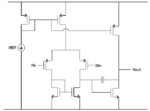esdeath_123
Junior Member level 3
I'm trying to design a two stage Miller Op-Amp using gm/Id method.

Starting from the second stage, from a given set of specifications, I found out that the gm and Id of the second stage can be computed. My question is, what if the computed gm/Id is out of bounds? From simulations, I was able to see that gm/Id has a max value of around 20-30 depending on the transistor. Do I adjust the current and/or the gm to set it within range? But this would change the overall GBWP and/or the Slew rate of the op-amp. And if I should change the gm/Id, what value should I set it to?
Also, some of my teachers say that from gm/Id, one can estimate vdsat. They said that 20 is around 100mV vdsat and 15 is around 200mV vdsat, always, IIRC. How is this done? Doesn't gm/Id and vdsat change depending on the transistor?
Finally, how do you set a gm/Id value? What I know is that it is also related to inversion regions (weak, strong, moderate) and that operation in weak inversion results to high gain, low bandwidth, high gm/Id and larger devices while strong inversion is the opposite and moderate is a balance of the two. Is this correct? What are other factors in choosing gm/Id?

Starting from the second stage, from a given set of specifications, I found out that the gm and Id of the second stage can be computed. My question is, what if the computed gm/Id is out of bounds? From simulations, I was able to see that gm/Id has a max value of around 20-30 depending on the transistor. Do I adjust the current and/or the gm to set it within range? But this would change the overall GBWP and/or the Slew rate of the op-amp. And if I should change the gm/Id, what value should I set it to?
Also, some of my teachers say that from gm/Id, one can estimate vdsat. They said that 20 is around 100mV vdsat and 15 is around 200mV vdsat, always, IIRC. How is this done? Doesn't gm/Id and vdsat change depending on the transistor?
Finally, how do you set a gm/Id value? What I know is that it is also related to inversion regions (weak, strong, moderate) and that operation in weak inversion results to high gain, low bandwidth, high gm/Id and larger devices while strong inversion is the opposite and moderate is a balance of the two. Is this correct? What are other factors in choosing gm/Id?